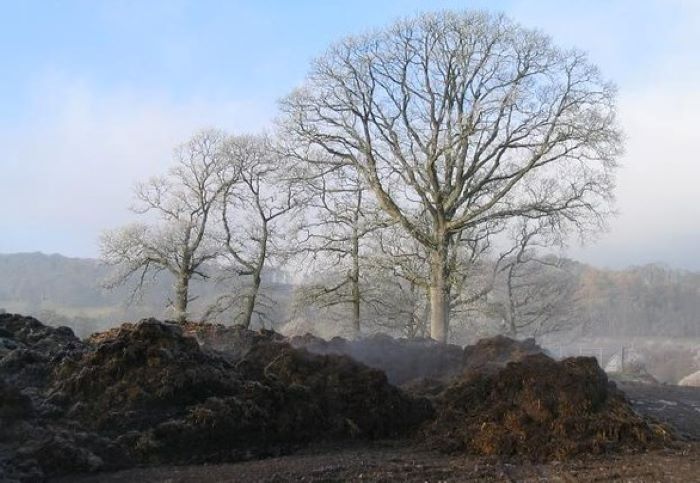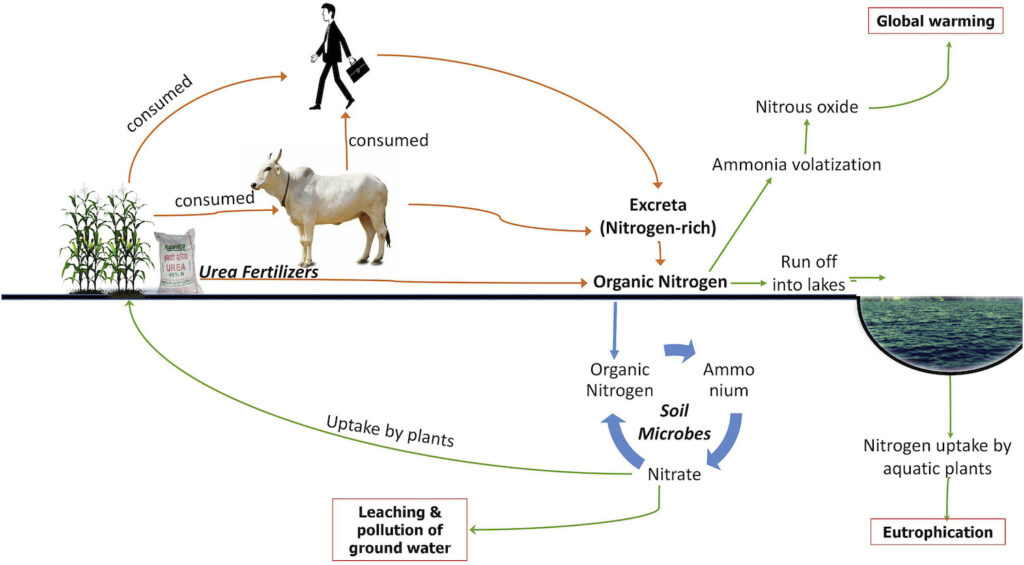
Mountains of manure

A large farm can produce more waste than an entire city. A feeding operation with 800,000 pigs could produce over 1.6 million tons of waste a year.1
Livestock animals in the US produce up to 20 times more manure than people – between 1.2–1.37 billion tons of waste.2
Livestock in general are directly responsible for 7.1 gigatonnes of carbon dioxide equivalent per year (Gt CO2eq/year). Of this total, 3.1 Gt CO2eq/year is in the form of methane (CH4), 2.06 Gt CO2 eq/year as nitrous oxide (N2O) and 1.92 Gt CO2eq/year as CO2 itself.3
Enteric fermentation is the largest direct source of these emissions, but the second largest is manure left on the field. Along with manure management, animal waste was responsible for 29% of livestock emissions in Africa and 22% in Asia between 2001 and 2010.4
Livestock produce 130 times more waste than humans.
Methane is emitted into the atmosphere from anaerobic decomposition of the excreted manure. 4
Manure contains high concentrations of nitrogen and phosphorus. If the manure is untreated, these leach into the soil and are washed by rain or snow into water bodies. Nutrients from manure and the chemicals used on crops are the leading cause of pollution to rivers and also poison wetlands, lakes and groundwater. When they reach the sea, they produce algae blooms that in turn release toxins that kill aquatic life such as fish, marine mammals, sea birds and coral reefs.

The impact of this process, known as eutrophication, increases greenhouse gas concentrations in a number of ways. When the algae blooms die, the decomposition emits methane – with the ‘greening’ of lakes predicted to increase methane emissions between 30% and 90%.5 Eutrophication also raises atmospheric carbon dioxide levels because surface waters are more acidic and starved of oxygen, and can absorb less CO2 from the atmosphere than previously.
REFERENCES
-
1.US Government Accountability Office. Concentrated Animal Feeding Operations: EPA Needs More Information and a Clearly Defined Strategy to Protect Air and Water Quality from Pollutants of Concern. U.S. GOVERNMENT ACCOUNTABILITY OFFICE: A Century of Non-Partisan Fact-Based Work .
-
2.Rogers, S. and J. R. Haines. Detecting and Mitigating the Environmental Impact of Fecal Pathogens Originating from Confined Animal Feeding Operations: Review. U.S. Environmental Protection Agency; 2005:1-185. Accessed 2021. https://nepis.epa.gov/Exe/ZyNET.exe/P10089B1.TXT?ZyActionD=ZyDocument&Client=EPA&Index=2000+Thru+2005&Docs=&Query=&Time=&EndTime=&SearchMethod=1&TocRestrict=n&Toc=&TocEntry=&QField=&QFieldYear=&QFieldMonth=&QFieldDay=&IntQFieldOp=0&ExtQFieldOp=0&XmlQuery=&File=D%3A%5Czyfiles%5CIndex%20Data%5C00thru05%5CTxt%5C00000024%5CP10089B1.txt&User=ANONYMOUS&Password=anonymous&SortMethod=h%7C-&MaximumDocuments=1&FuzzyDegree=0&ImageQuality=r75g8/r75g8/x150y150g16/i425&Display=hpfr&DefSeekPage=x&SearchBack=ZyActionL&Back=ZyActionS&BackDesc=Results%20page&MaximumPages=1&ZyEntry=1&SeekPage=x&ZyPURL
-
3.Gerber, et al. Tackling Climate Change through Livestock: A Global Assessment of Emissions and Mitigation Opportunities. Food and Agriculture Organization of the United Nations (FAO); 2013. https://www.cabdirect.org/cabdirect/abstract/20133417883
-
4.Adegbeye MJ, Ravi Kanth Reddy P, Obaisi AI, et al. Sustainable agriculture options for production, greenhouse gasses and pollution alleviation, and nutrient recycling in emerging and transitional nations – An overview. Journal of Cleaner Production. Published online January 2020:118319. doi:10.1016/j.jclepro.2019.118319
-
5.United States Environmental Protection Agency. Nutrient Pollution. United States Environmental Protection Agency. Published May 6, 2020. Accessed March 18, 2021. https://www.epa.gov/nutrientpollution
-
6.Beaulieu JJ, DelSontro T, Downing JA. Eutrophication will increase methane emissions from lakes and impoundments during the 21st century. Nat Commun. Published online March 26, 2019. doi:10.1038/s41467-019-09100-5